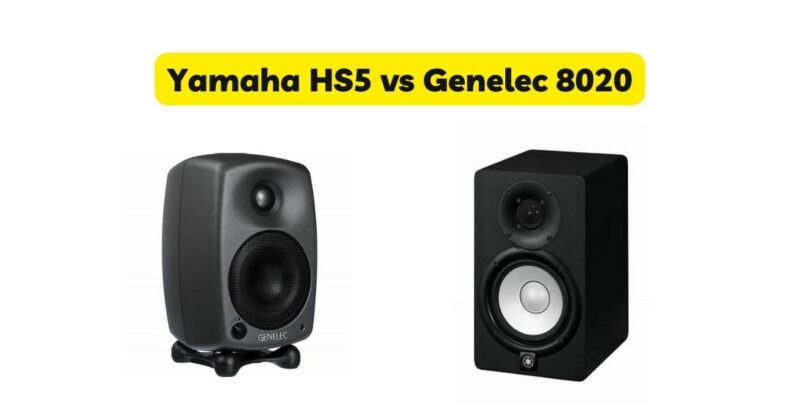When it comes to compact studio monitors, the Yamaha HS5 and Genelec 8020 are two popular choices among audio professionals and enthusiasts. In this comprehensive comparison, we will examine their features, sound performance, design, build quality, and other important aspects to help you make an informed decision based on your specific needs and preferences.
Design and Build Quality
The design and build quality of studio monitors are crucial factors that can impact their overall performance and durability.The Yamaha HS5 features a compact and functional design with a black enclosure and a white woofer cone. It is equipped with a 5-inch cone woofer and a 1-inch dome tweeter, both designed by Yamaha for optimal performance. The monitor’s enclosure is built to minimize unwanted resonance and provide a balanced sound reproduction. The HS5’s build quality is excellent, ensuring stability and longevity.In contrast, the Genelec 8020 boasts a distinctive and elegant design. The monitor is encased in a robust die-cast aluminum enclosure, which not only provides excellent durability but also helps in reducing resonance and unwanted vibrations. The 8020 features a 4-inch woofer and a 3/4-inch metal dome tweeter, engineered by Genelec for accurate sound reproduction. The build quality of the Genelec 8020 is exceptional, reflecting the brand’s commitment to precision and craftsmanship.
Sound Performance
The sound performance of studio monitors is a crucial aspect to consider, as it directly impacts the accuracy and quality of audio reproduction.The Yamaha HS5 offers a frequency response range of 54Hz to 30kHz, providing a well-balanced sound reproduction across the entire frequency spectrum. It delivers clear and detailed audio with a focus on accuracy. The HS5’s sound signature is known for its neutrality, making it suitable for critical listening, mixing, and mastering applications. The monitor’s integrated bi-amp design ensures efficient power distribution to the woofer and tweeter, resulting in enhanced clarity and transient response.Genelec 8020 is renowned for its exceptional sound quality and precise imaging. Despite its compact size, it delivers an impressive frequency response range of 66Hz to 20kHz, allowing for accurate reproduction of the audio material. The 8020’s sound signature is characterized by its clarity, transparency, and excellent stereo imaging. The monitor utilizes Genelec’s advanced Directivity Control Waveguide (DCW) technology to provide controlled directivity and minimize early reflections, resulting in an accurate and focused soundstage.
Connectivity and Features
Both the Yamaha HS5 and Genelec 8020 offer a range of connectivity options and additional features to enhance the user experience.The Yamaha HS5 provides balanced XLR and 1/4-inch TRS inputs, ensuring compatibility with various audio sources. It also includes room control and high-trim switches to compensate for room acoustics and speaker placement. Additionally, the HS5 features an auto-standby mode that helps conserve energy when the monitor is not in use for an extended period.The Genelec 8020 offers balanced XLR and 1/4-inch TRS inputs, ensuring flexible connectivity options. It also includes Genelec’s Intelligent Signal Sensing (ISS) technology, which automatically detects the presence of an audio signal and switches the monitor on, eliminating the need for a separate power switch. The 8020 also features advanced protection circuitry to prevent overload and damage to the drivers.
Price and Application Considerations
In terms of price, the Yamaha HS5 is generally more affordable compared to the Genelec 8020. However, it’s important to consider the overall value, sound performance, and specific application requirements when making a purchasing decision.The Yamaha HS5 is an excellent choice for home studios, project studios, and music enthusiasts who prioritize accurate sound reproduction at an affordable price point. It offers a balanced sound signature, compact design, and solid build quality, making it suitable for a wide range of audio production tasks.The Genelec 8020, on the other hand, is widely used in professional recording studios, broadcast facilities, and high-end audio production environments. Its exceptional sound quality, advanced driver technology, and precise imaging capabilities make it ideal for critical monitoring tasks where accuracy and detail are of utmost importance.
Conclusion
In conclusion, both the Yamaha HS5 and Genelec 8020 offer outstanding sound performance, design, build quality, and additional features. The Yamaha HS5 provides a balanced and accurate sound reproduction at an affordable price, making it an excellent choice for home studios and budget-conscious users. The Genelec 8020, with its precision engineering, exceptional sound quality, and advanced features, caters to professional recording studios and audio production environments where accuracy and detail are critical.Consider your budget, specific application requirements, and desired sound characteristics when making a decision between the Yamaha HS5 and Genelec 8020. Both options provide reliable and accurate monitoring, allowing you to achieve high-quality audio productions.


